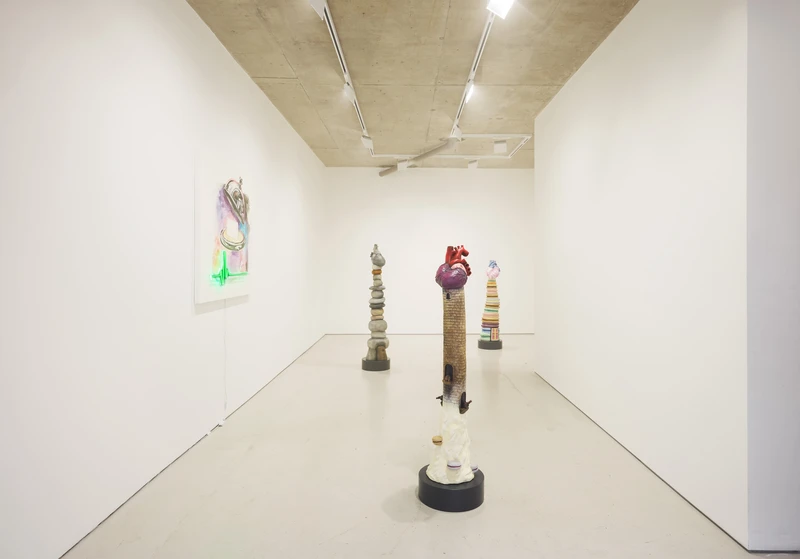Ilaria Vinci: Introverse
6 Jun-5 Jul 2025
PV 5 Jun 2025, 6-8pm


OPENING RECEPTION: THURSDAY 5 JUNE, 6-8PM, OPEN TO ALL
EXHIBITION TOUR AND MUSICAL PERFORMANCE WITH ILARIA VINCI AT ALICE AMATI: FRIDAY 6 JUNE, 11AM-12:30PM, RSVP REQUIRED
6 JUNE – 5 JULY, 2025 27 WARREN STREET W1T 5NB LONDON
There is a subtle movement running through Ilaria Vinci’s work—one that does not reach outward, but rather folds inward. It is a descent, both as excavation and as quiet surrender. INTROVERSE, a title that evokes both the psychological state of introversion and the act of turning inward, is not just an exhibition but an immersive exercise. In a time overloaded with stimuli, obsessed with visibility, and shaped by the speed of digital images, Vinci offers a counter-gesture: to slow down, withdraw, and enter the hidden architecture of imagination and the self.
The exhibition unfolds across two levels. On the upper floor, three vertical sculptures—anti-monumental towers crowned with anatomical hearts—stand as embodiments of bottled emotional states. Each one proposes a different survival strategy: a heart turned to stone, cold and impenetrable; a heart as fragile as a macaron, ready to dissolve; and a heart fortified and armed, enclosed within a defensive structure. Smoke rises from the veins of each heart, suggesting internal processes—emotional combustion, or the alchemy of feeling. These sculptures don’t provide answers—they pose questions. They are poetic tools, mixing irony with discomfort: a playful assemblage of elements borrowing their aesthetic language from a diverse range of influences and styles including Candy-core, Gothic, Zen gardens, and anatomical illustrations. Even when they appear unfamiliar, they resonate because they draw on a visual world we already inhabit— one shaped by therapeutic memes, pseudo-spiritual icons, and the casual rituals of self-narration. In this sense, Vinci’s aesthetic is radically contemporary: not escapist, but disruptive, using fantasy as a way to unearth the hidden logic of the everyday.
On the lower level of the gallery, a series of watercolour drawings depict onions sliced open to reveal not the typical bulb scales of this vegetable, but labyrinths. These allude to inner diagrams, speculative architectures where fragility meets complexity. Here, the humble onion becomes a noble symbol, an emblem of knowledge that deepens rather than resolves. Each layer leads to another puzzle; every contour marks a potential path. These forms are superimposed on representations of the golden ratio and drawing grids—tools that are typically erased, but here, preserved and elevated. Even the process, Vinci seems to suggest, can be revelatory.
Connecting the two levels of the exhibition space - both physically and metaphorically – is I could, I should, I wouldn’t, a neon-lit watercolour depicting a metal cloche revealing a blank place card underneath it. The metal cloche recalls the world of cuisine, which is also echoed in the oversized paper place card reading ‘reserved’ and occupying the lower ground floor of the gallery. The setting evokes a murder mystery dinner party, where each object is a clue and the ‘reserved’ sign suggest someone is still expected to arrive.
Vinci’s idea of “inner architecture”, which she understands as the invisible structure of the self, runs throughout the exhibition. This concept draws on Luigi Serafini’s imagined cities and on fantastical, self-built projects like Ant Farm’s House of the Century, where organic forms generate eccentric, impractical interiors. In Vinci’s practice, architecture becomes anecdote—almost a character with a life of its own. A scale model or technical drawing carries the same conceptual weight as a completed structure: once the viewer engages with the idea, it begins to exist, even if only virtually or in the space of the mind. This approach mirrors the logic of her broader practice, built from object-worlds where a heart, an onion, a spiral, or a curl of smoke becomes a node in a speculative network. Vinci does not offer clear messages; she opens up spaces of possibility. She suggests rather than explains, invites rather than instructs. Her works ask for time and attention—and in return, they offer ways to look within: a quiet, generative, and introverse silence.
— Text by Matteo Binci